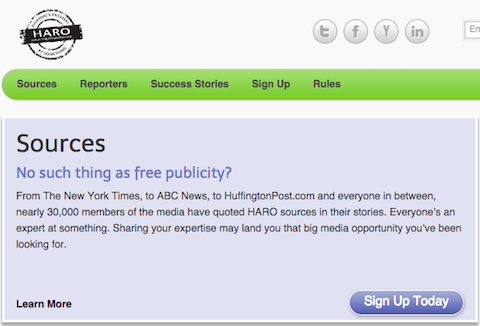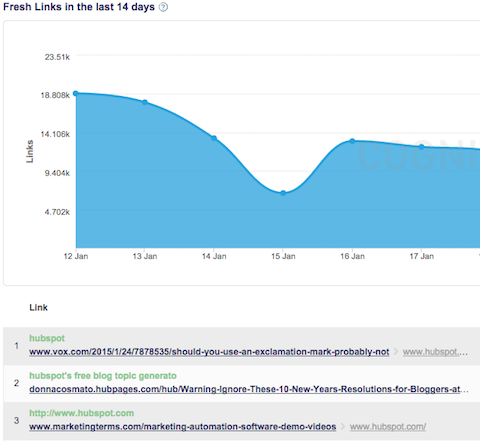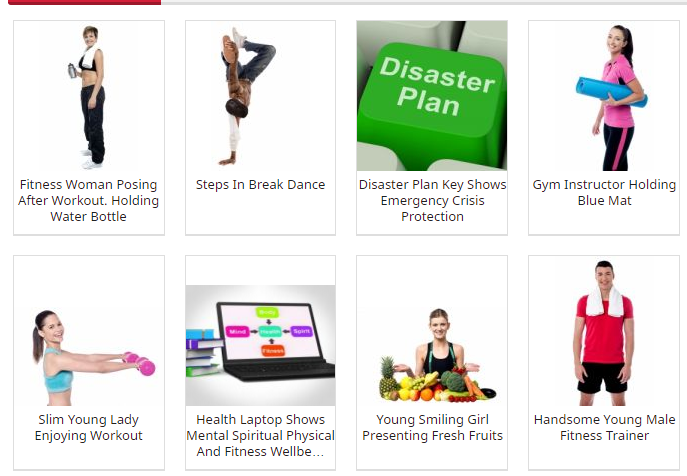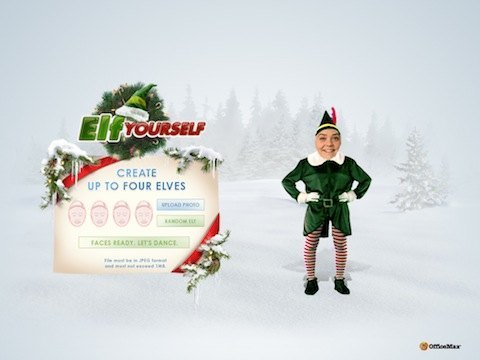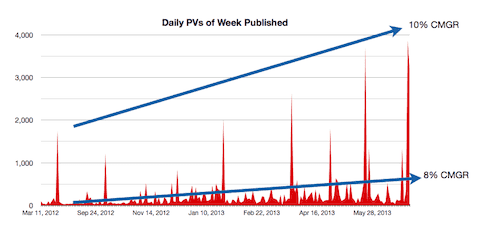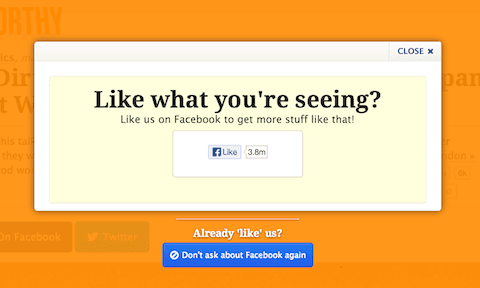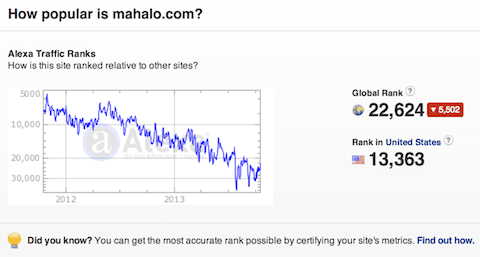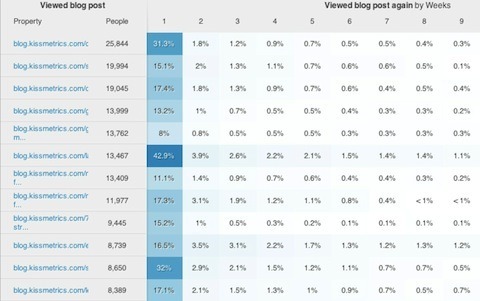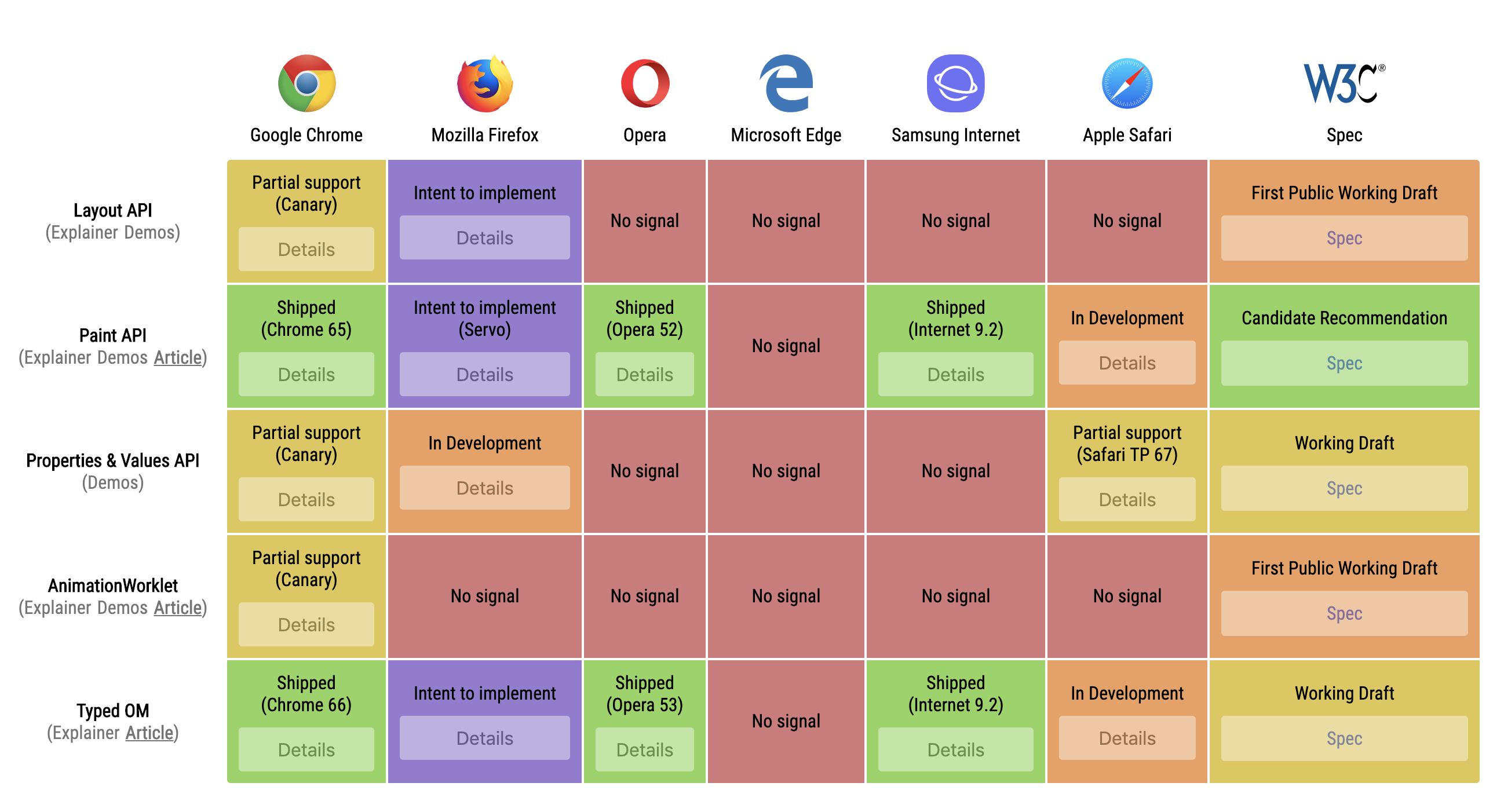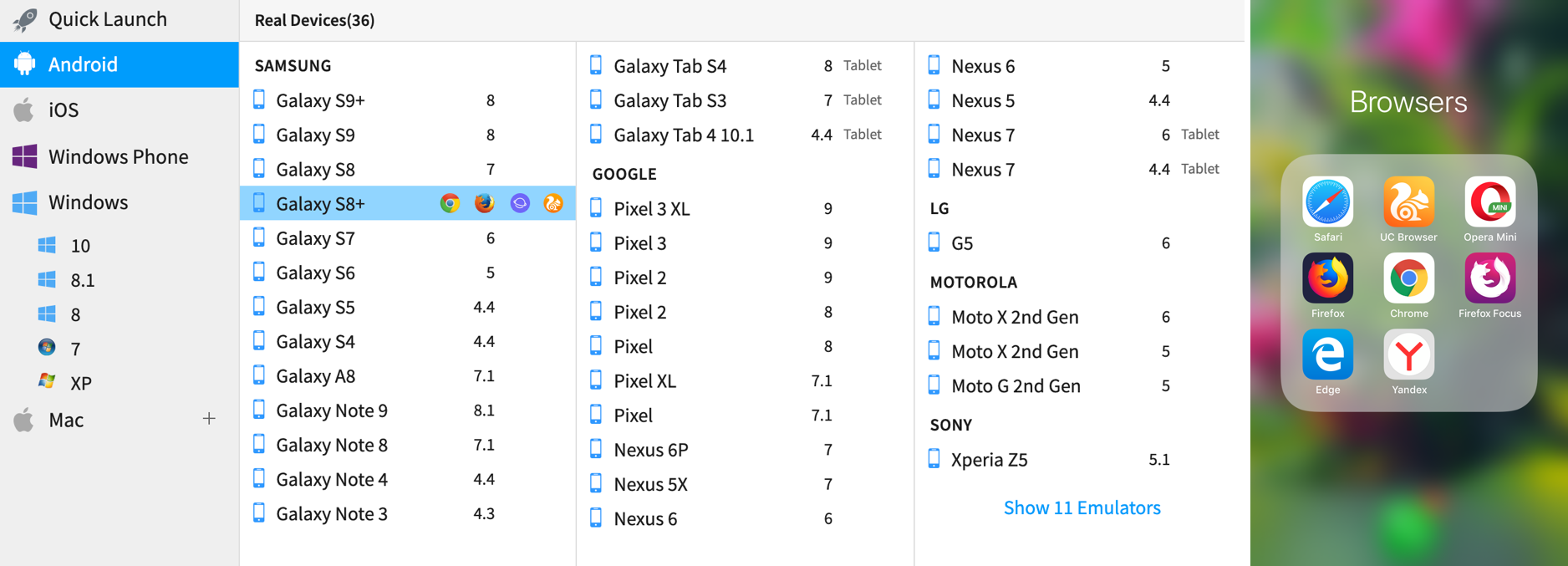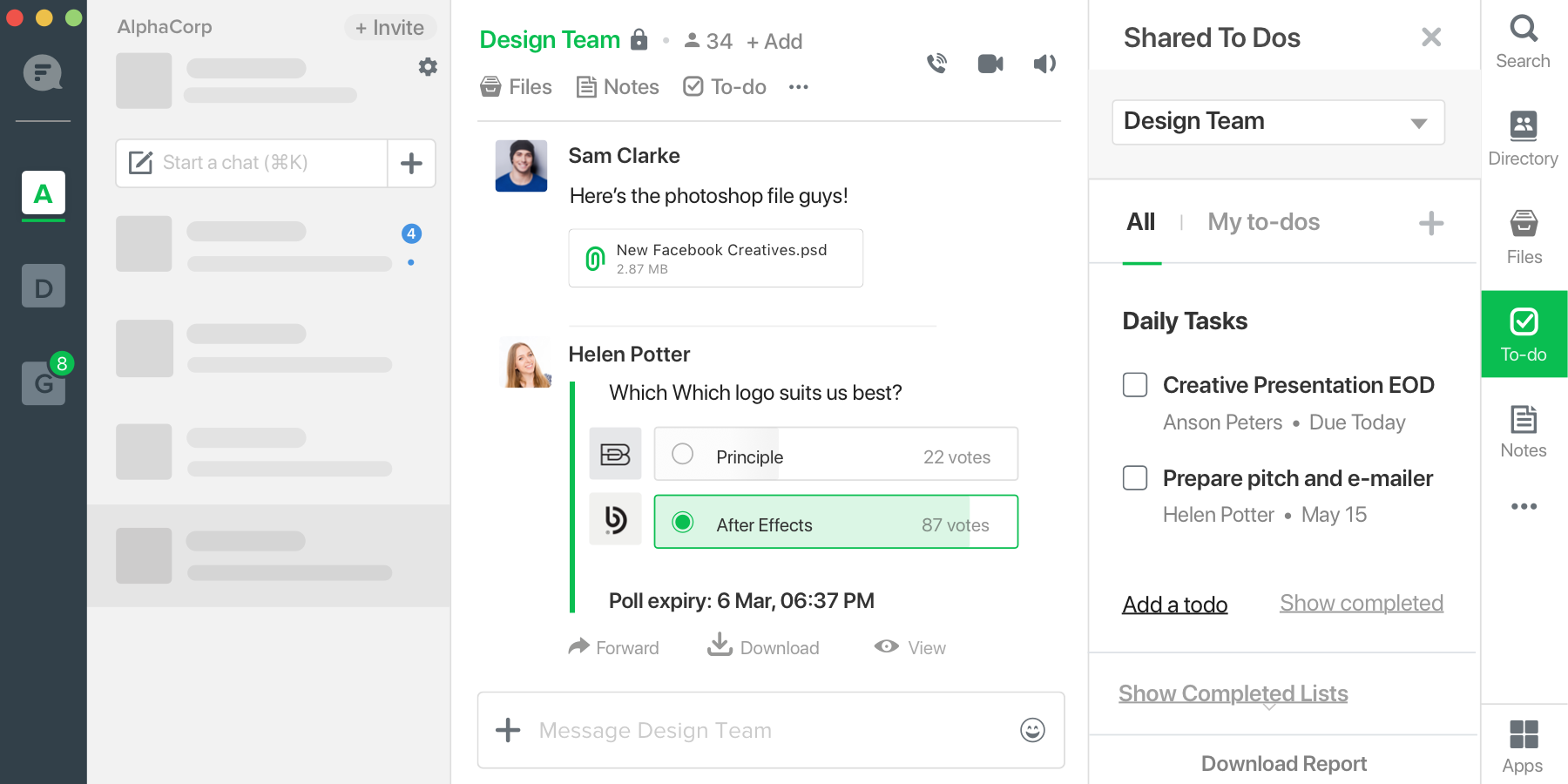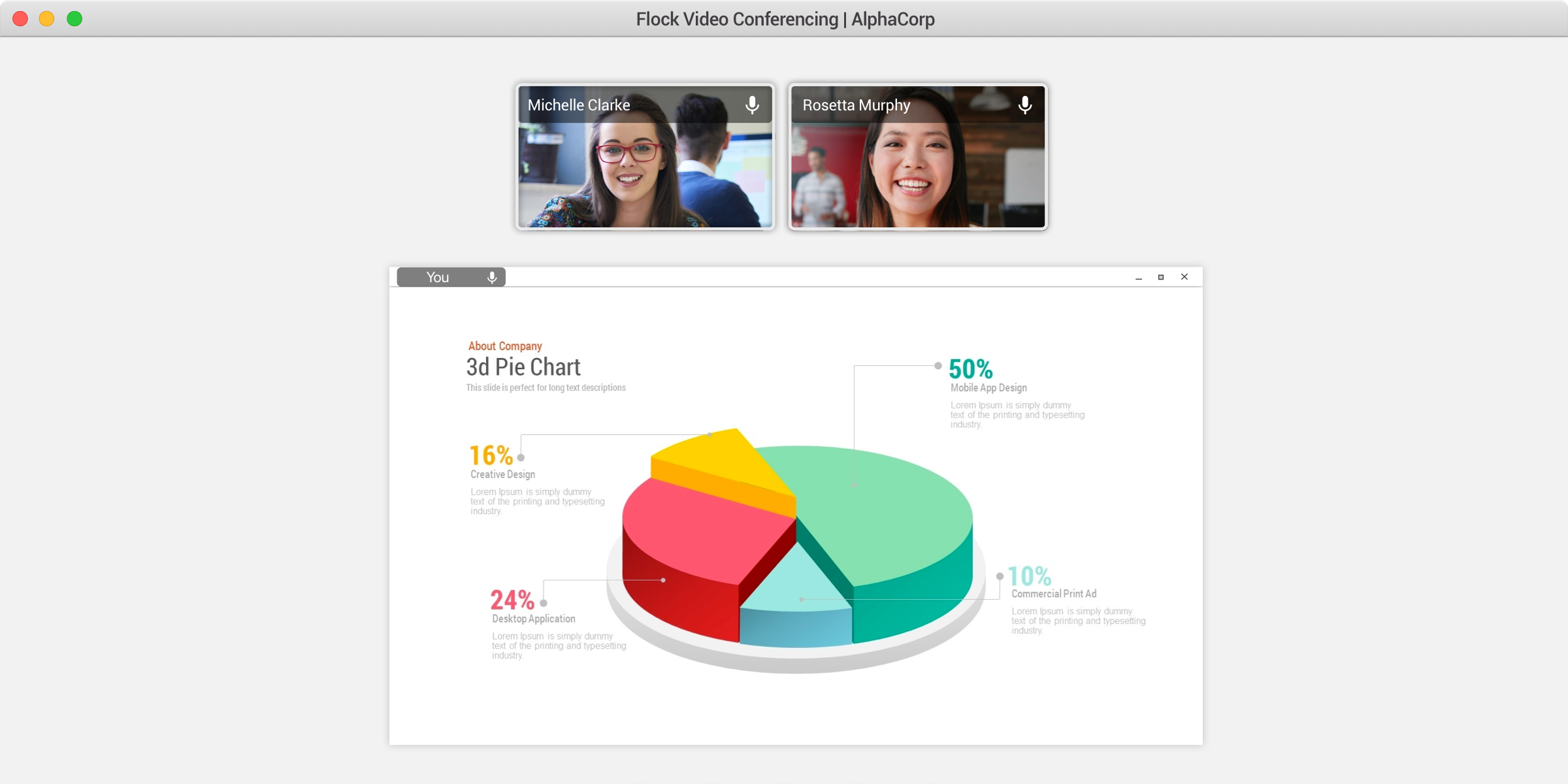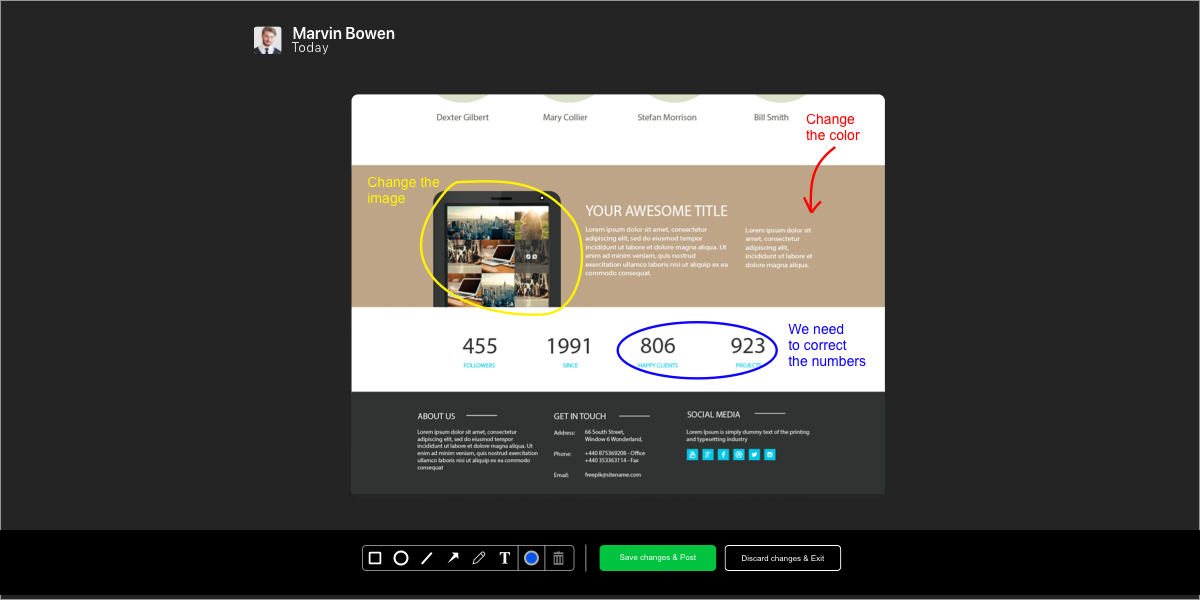Creating a content marketing strategy isn’t as easy as it may seem. You can’t just throw hundreds of articles up on the web and expect them magically to rank well on Google.
Yes, understanding that you should be leveraging content marketing is the right first step, but before you launch your campaign, there is a lot that you ought to know.
No matter how awesome your content is, if you’re not marketing it, sharing it, and promoting the heck out of it, nobody will read it.
With this straightforward guide, you’ll learn 34 content marketing tips that every marketer should know.
Let’s get started.
1. Define the objective of your content
The first and most important thing you can do before your pen ever touches paper or your fingers touch the keys is to define the objective of your content.
As the old quote goes,
“Failing to plan is planning to fail.”
If you do not have a definite goal for your content, not only will you likely write an incoherent piece, but you will also likely have difficulty marketing it in the proper channels.
As I detail in my Advanced Guide to Content Marketing, there are several goals you need to define before you start churning out content.
- Decide how you will use this content to grow your business. (Is it to generate leads, improve sales, boost your marketing, or create a community? There is no wrong answer—it’s up to you.)
- Decide on a specific goal for the content once you have determined how it will be used.
- Develop the core message that will be congruent through all your content.
- Identify your competition and analyze them.
A content marketing Excel sheet like the ones pictured below can be a huge help.


You can find samples and templates for these spreadsheets online.
Here’s one from the Content Marketing Institute. (Careful. That link will download the spreadsheet automatically.)
Hubspot offers a few as well. I recommend you check these out before you spend hours creating and formatting your own.
A good calendar will include not just dates but the topic, the content, and the keyword focus of the article.

The level of detail is up to you. Some campaigns are pretty simple and maybe only need a date and a title. Other campaigns can be advanced and may include details such as keyword focus, persona target, author, geotargeting, product focus, seasonal push, etc.
Keep things as simple as possible, and you’re more likely to succeed.
Know your audience: Who is this for?
If you don’t know for whom you’re writing, you’re going to end up writing pointless content. Failure to know your audience is a failure to execute a successful content marketing campaign.
When the failure happens
This failure can take place either prior to launch or during the early stages of a content marketing plan.
Why failure happens
Content is for an audience, not just for your brand. The only way you’re going to survive is if people are actually reading and interacting with the content.
If you don’t have a target audience, then you won’t know what to write, how to write, or how to address the vague and disembodied entity of a “non-audience.”
Solution
Create a user persona. Don’t try to wrap your mind around an audience consisting of thousands of people. That doesn’t work. Instead, just think about the one person that is your customer.
Here’s an example persona that I sketched out:

She has a name, an age, and a location. She has likes and dislikes. (Jen has a nephew named Jackson, who is three years old. She bought him a Despicable Me toy off Amazon for his last birthday.) We have detail, understanding, and the power to write directly to Jen.
Now, we’re going to write content with Jen in mind. Jen is going to type in search queries that direct her to our content. Jen is going to love our content.
What’s more, she’s going to convert — she and about 291,658 other people in your target audience.
Know your message: What are you saying?
Content, by its very definition, says something. What is your content saying? Do you even know?
When the failure happens
This takes place early on in a content marketing campaign. When the hey-let’s-do-content-marketing bug strikes randomly, it causes people to rush into the project without even knowing what their message is.
Why failure happens
Content is meaningless unless it has a message. The message is the one thing that your content all boils down to. You should be able to sum it up in a phrase or a sentence.
If you don’t have a message, you’re going to be producing meaningless words on a screen. Sooner or later, you’ll lose motivation for content because it has no driving force.
Solution
The solution is both simple and relatively easy. You have to understand the purpose of your entire business. Content marketing should serve that purpose by communicating a specific message.
Here’s the three-step process for developing your message:
- Get a hold of your mission statement. If you don’t have one, make one. Example from Crazy Egg: to provide affordable, effective heat-mapping technology that helps people improve on-page conversion.
- Write down your core message. This is the benefit for your customer. Crazy Egg’s core message: you can boost your website’s profit within 30 days.
- Write down your secondary messages. What are the various things that are related to your core message? Crazy Egg’s secondary messages: web design, conversion optimization, blogging for business, conversion, copywriting, scrambled eggs, analytics.
There are a lot of possibilities for content. In the subtext of every blog post, webinar, and YouTube video is this message: We can boost your website’s profits in 30 days.
Not only is the targeted traffic going to rush in, but you’re also going to be delivering a message that hits your customer where it counts.
2. Focus on the headlines
Which would you be more likely to click on?
“How to Totally Shred Pounds of Fat and Uncover Your Dream Body in Only ONE Month!”
Or
“Burn Fat with This Program!”
The answer is obvious.
No matter whether you are creating videos, articles, or podcasts, the headline is one of the most important aspects of successfully getting your content in front of your target audience.
Make your headlines juicy and enticing, and your conversion rates will skyrocket. Bottom line: your business will grow.
Make your headlines boring and generic, and the most you’ll get is maybe hundreds of views (if that).
You’ve seen the juicy and tantalizing headlines all over the web. Even something as mundane as a pipeline can seem exciting when pitched the right way.

You don’t need to be sensational to craft a great headline. Instead, you need to be hyper-focused on what your readers want and make a promise that earns their click.
In fact, you use a simple formula to make the process easier. Try this one, from Buffer.

3. Don’t B.S. your readers
In your quest to create epic content, you have to realize that your reputation online is everything. It takes hard work to maintain your reputation, and it can be destroyed in a matter of minutes. Lost reputation can take years to rebuild.
EVERYTHING you publish should be well-researched and fact-checked (or have a decent train of logical thought if the concept you are trying to explain is more philosophical in nature).
If you start creating clickbait content that makes promises you cannot deliver on, your reputation will be tarnished and will be nearly impossible to recover.
However, even if you are putting out less content than the others in your industry, your content will still outperform your competitors’ if it is grounded in hard data. Telling the truth through your content, even when it’s ugly, will earn you a sterling reputation and the trust of your customers.
4. Make your content super actionable
Have you ever noticed that I strive to offer advice you can take action on immediately?
There is a reason why.
When people read articles, especially informative articles, they don’t want theory or conjecture. They want concrete steps they can act on right away—actionable steps.
I’ve learned what my audience wants, and I try as hard as I can to deliver it.
Whether you include an “Action Step” at the end of each of your articles or simply write in a style that carries actionable information throughout an article, it’s up to you. But you have to make sure whatever you put out there, people can act on it and act fast.
The model I use for making my content actionable looks like this:

- Create value and fix pain: The headline I created for my article promises a solution to your pain and an offer of value. Heck, it’s free for you to read this article, and you get plenty of great advice, right?
- Build relationship: I’ve pulled you in. Now, I want to build a relationship with you. If you’ve been a reader for a while, or simply know about my success, you may already have a relationship with me. If not, you can check out my ugly mug on the sidebar or even email me.
- Earn trust: In my article, I’m proving the fact that you deserve my trust. How? By providing solid researched and experience-based information.
- Take action: You, the reader, can totally take action on this. In fact, based on these four bullets, you can develop your own plan of attack for an actionable content strategy.
5. Create engaging and original content
The Internet is full of crap, and if you want to succeed, you have to be the shiny diamond in the rough. One of my favorite examples of content that stands out is Craig Clemens’ article on “How to 10x Your Income Over the Next Four Years”.
Where most articles begin with something bland and generic about how you should wake up earlier, skip the Starbucks latte, and invest your pennies in some mutual fund, Craig comes out with a bang, offering the highly controversial, engaging, and original thought: the first step should be to cut out porn.
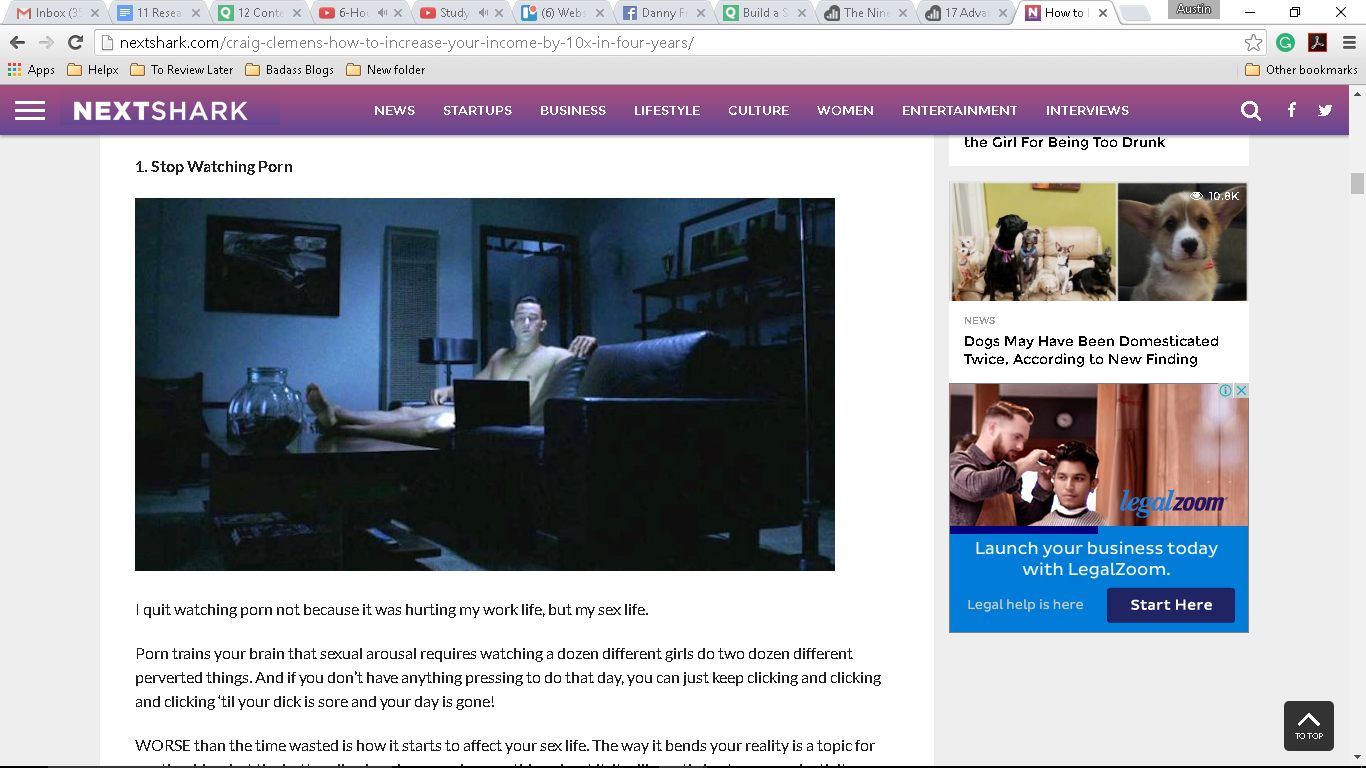
This is engaging. Why? Because most people have a visceral response to something like porn.
The content is also original because Craig is willing to say something that not many people can say.
Originality is engaging, so don’t be afraid to stick your neck out there. It’s worth it.
6. Produce consistent content
It’s amazing how many people go “rah-rah, content marketing” but then don’t even have a plan for creating it! The quickest way to kill a content marketing campaign is to have zero content. Or to start to produce content and then stop. I’ve seen this happen way too many times.
When the failure happens
Failure strikes some time after the launch of content marketing. The excitement that initially fueled content marketing gives way to the weariness of producing it. It could be a couple weeks. It could be a few months.
Why failure happens
Content marketing demands consistency. You can’t just throw a bunch of content on the web and expect it to generate traffic for the long haul.
Search engines prefer to rank sites that show signs of life. You’ll reap maximum SEO benefit if you produce fresh content consistently.
When search engines rank results, they tend to prefer pages that have historic authority and fresh content. You can get an idea of how this works by looking at the SERP screenshot below. Notice that the second position result was published just a few weeks ago. The next result down is from two years ago. The fourth result is from several weeks ago. The fifth result is from a couple of months ago.
All of that fresh content is stacking the SERPs with a lot of value. If I wasn’t producing content on a regular basis, I would be losing serious traffic potential.

Once you turn off the faucet of content, you turn off a major SEO channel.
Solution
There are a number of reasons why content marketing drops off after a while, but I’ve discovered three main reasons. Here are those reasons and their respective solutions:
- You run out of ideas: go back to your company message (see the point above). Flesh out your mission statement, core message, and secondary messages. When you do, you should have a list of potential blog topics. Those are your ideas.
- You don’t have a plan: though an “editorial calendar” may not be your thing, you do need some sort of a plan for producing content. Who’s going to produce what? When will it be published? It helps to create a schedule for this.
- It takes too much time: if necessary, hire help. There is an army of freelance writers and content creators who will be more than happy to help you develop content. You can find them through Craigslist ads, Textbroker, or ODesk.
7. Always include videos and pictures
A picture is worth a thousand words.
So, what is a 3,000-word article with 6 photos worth to someone?
While I will leave the math to you, it is important to realize humans are visual creatures and we process images much faster than text. If you want to increase the amount of user response and the number of social media shares, adding images and videos can be one of the best ways to do this.

I try to include as many relevant images as possible in my articles.
It’s hard work finding those pictures and adding them into WordPress, but I’m willing to do it. Why? Because if this 2,000+ word article had zero images, you probably wouldn’t read it.
8. Get an awesome quote from an industry leader
We all know the power of social proof. This power is doubled when you can get it from an industry leader.
If you have created some epic content and already have built a solid platform to share it on (though this can work even if you are a total beginner), reaching out to an industry leader for their thoughts on your work is a great way to improve your content marketing through social proof and get your name associated with A+ players.
The process for reaching out to them is pretty straightforward as well.
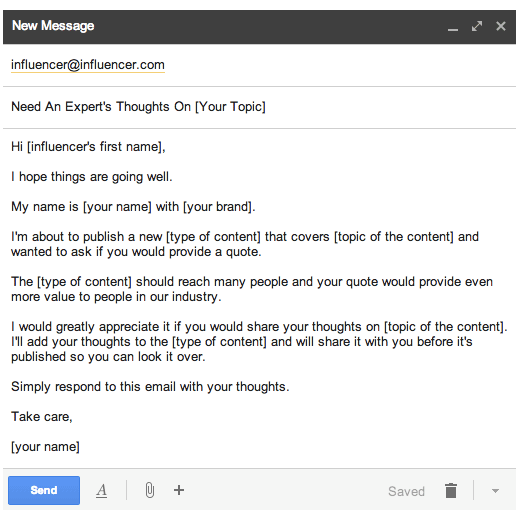
Send them an email or message, and boom. Instant credibility.
9. Turn your content into a video or podcast to broaden its scope
Some people prefer to learn through watching or listening, and some through reading. If you limit your content to the written word, you are massively short-selling yourself and your audience. You are cutting out a whole portion of your audience who might love your work but might not prefer its format.
The same is true if you are a YouTuber, reading this guide. Get on Fiverr, and pay someone to transcribe notes from your informational videos so that people with different learning styles can also have access to that information.
10. Think like a searcher
Which piece of content do you think generates more traffic:
My advanced guide to content marketing that I spent well over $30,000 to produce and was read by 361,494 people when I launched it… or a blog post that I wrote about motivational business quotes that I created in less than two hours?
The one on content marketing, right?
Well, if you look at the screenshot below, you’ll see that the motivational business quotes article got read by 926 people over a period of 24 hours.

And if you look at this image of statistics on the content marketing guide, you’ll see that only 500 people read it on that day.
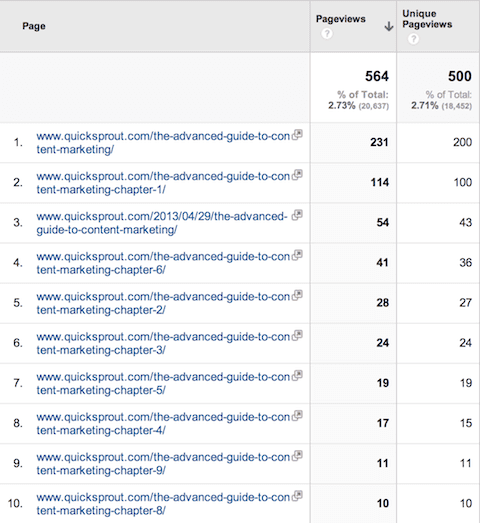
Sure, if you combine all of the traffic all 3 of my advanced guides get each day, it ranges between 2,000 and 3,000 visitors, but I spent well over $100,000 for all 3 of those guides… while that post on business quotes only took me two hours to write.
Do you know why? It’s because the business quotes blog post is more tailored around search engines than the content marketing guide.
Just think about it… are you more likely to search for “content marketing” or “business quotes”?

As you can see from the Google trends screenshot, more people are interested in business quotes than they are in content marketing.
When writing, don’t just think about people, but think about searches too. From keywords to queries someone might type into a Google search box, try to write content and titles that appeal to both people and search engines.
If you want to maximize your search traffic by pleasing both people and search engines with your content, check out this case study on Problogger. It breaks down how one company increased their organic traffic by 203.5% in 3 months.
11. Monetize your content
Content is not an end in itself. It serves a purpose: sales. If your content isn’t driving sales, it may look good, but it’s not doing good.
When the failure happens
A company can produce content for a long time without connecting it to its core message and end goal. Content can and should drive conversions.
Why failure happens
The fail point is obvious. If your business isn’t getting conversions from your content, then your content is useless. The entire purpose of content marketing is to drive more sales to your business.
Solution
Don’t be scared of calls to action. This is the only way to get sales.
Look at what I’m doing with my site. I’m producing awesome content because I really do care about you and the success of your online business. But I also have my own business to care for and grow.
So, I use a number of calls to a variety of actions. They’re not annoying, odious, intrusive, obnoxious, or troubling. And they get me results.
First off, every visitor is going to see my first call to action, which is a tool on my homepage.

Then, from my blog main page, he or she is going to see some more calls to action.

When you scroll down, you’ll see two more:

Click on any blog article, and I still have calls to action.
They are on my persistent header, on the sidebar, and at the end of articles. They are in strategic and optimized spots.
I’m connecting my content to conversions. The solution to conversionless content marketing is simply to use calls to action, to run A/B tests on your calls to action, and to invite users to do the next logical thing…to buy your product.
12. A deal isn’t a deal, unless people think it is
Blog readers don’t like to spend money… there is no way to monetize them, right?
Sure, making a few thousand dollars here or there isn’t too hard, but no one makes millions of dollars from content, right?
In most cases you are right. Most people don’t make much money from their readers. It’s not because your readers aren’t interested in buying your products or services; instead, you just don’t know how to sell to them.
Two people who are really good at converting blog readers into customers are Ryan Deiss and Vishen Lakhiani. They do it so well that they even talk about how they are able to create income streams of over $15,000,000 a year without raising a dollar in venture capital.
One of the most interesting tactics I learned from Ryan is that a great way to convince people to buy a product or service from you is to offer a discount, but not by using the tactic in the image below:

The reason the image above doesn’t make you feel like you are getting a discount is because when you first see this product, you are seeing it for $127. It doesn’t matter that the product was originally priced at $297 because you never experienced the product selling for $297.
If you first drive people to a page that shows that the product is selling for $297 with no discounts, you may make a few sales. If you offer a discount a week later and sell the same product for $127 for a very short period of time, you should make a lot of sales because people originally saw the item for $297.
My buddy recently tried this with his real estate website, and he was able to increase his monthly revenue by 316%. This is also the same reason Groupon works because you know you are getting a good deal when you buy from the site.
Discounts and deals are a great way to monetize your reader base, just make sure they know they really are getting a deal. Putting a few slashes through a price isn’t enough. Your readers need to know that this is a deal of a lifetime and they need to jump on it now.
13. Don’t always go for the sale
Ever feel like a sleazy used car salesman when creating content?

It’s not a good path to be on.
In fact, this is perhaps the number one way to turn off would-be readers and lose the readers you’ve currently got.
No one wants to be bombarded with “Buy Now!” messages when they’re trying to kick back and read some content.

It’s distracting and detracts from the overall user experience.
Here’s the thing about content marketing.
It’s one of the more long-term inbound strategies.
It doesn’t typically involve going for an instant sale.
Content marketing is about building relationships, creating rapport with your audience, and establishing trust over time.
The mentality is that if you take the time to create awesome content that’s genuinely useful, you’ll be primed to make a larger volume of sales down the road.
Therefore, it’s important to have the right mindset when approaching your content.
Here are a few techniques that I recommend:
- Avoid using interstitials on your website. Google actually started penalizing certain sites that use them.
- Place your focus on educating rather than selling. Believe me. If you educate your audience and solve a problem for them, the sales will follow.
- Don’t plug your business or include a CTA until the end of your content.
- Work on building rapport and establishing trust before asking your audience to buy anything.
14. Appeal to your audience’s emotions
As hard as we try to be logical and rational, we’re all emotional beings to some extent.
There’s just no getting around it.
If you can form an emotional connection with your audience, I can guarantee that your content will have a significant impact.
There’s a particular quote I love from an article titled “The Feelings Economy.”
It goes like this:
In an oversupplied economy, customer feelings drive purchase decisions and profitability.
I think this really nails it. The brands that tend to thrive are the ones that are able to elicit the right emotions and hit the sweet spot.
How exactly do you appeal to your audience’s emotions?
Well, you start by understanding which specific emotions on average generate the biggest response:
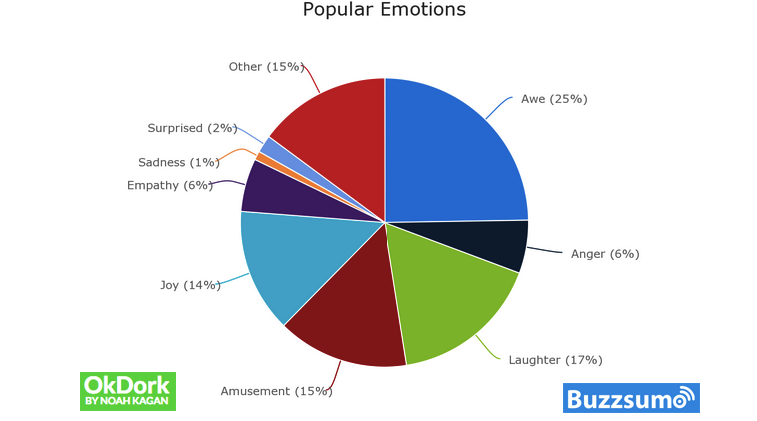
According to research from OkDork and Buzzsumo, your best bet is to create content that evokes:
- Awe
- Laughter
- Amusement
- Joy
More specifically, I recommend using images and stories in your content to trigger these types of emotional responses.
That’s because they’re great at targeting the limbic system, which controls basic emotions.
15. Incorporate images of faces
You might have noticed that I use a lot of images of people’s faces in my content.
Case in point:

I also place an image of my own mug on my website:

Why?
Because, as it turns out, there is power in facial expressions. It’s basically the universal language.
Allow me to explain.
Say you’re trying to interact with someone from a foreign country who speaks an entirely different language. Communicating with words is likely to be pointless.
What they’re saying sounds like gibberish to you and vice versa.
But you can always understand facial cues.
In fact, that’s how babies largely understand the world. Before they develop language, they primarily rely upon their parents’ facial expressions and tone of voice to extract meaning.
The point I’m trying to make here is that the human brain has an innate ability to process facial cues, which makes images of people’s faces ideal for conveying emotion.
Images can also help you establish trust.
Notice how Tim Ferriss’s photo gives off the vibe that he knows his stuff and that signing up for his course should prove helpful:
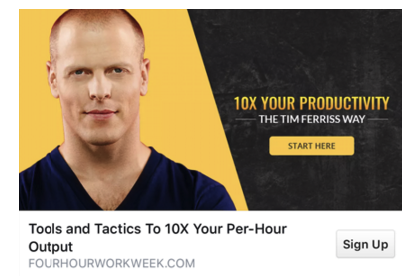
You can do yourself a big favor by weaving images of people into your content. Doing so can make your audience feel a certain emotion as well as perform a specific action.
16. Use colors to elicit emotion
What’s another way to get your audience to feel a particular way?
Using the right colors.
Each color has a certain meaning, so using the color that matches the emotion you’re looking to target can be highly advantageous.
Here are some examples of the meanings of color in the western world:

The key is to identify the particular emotion, feeling, vibe you’re going for and incorporate the relevant color(s) in your content.
I don’t have enough time to adequately explain this topic to do it justice here. But I’ve covered it in depth before, and you can learn all about it via this resource.
17. Focus on relieving pain points
Conventional marketing wisdom says that showcasing the benefits of a product/service and ways it will improve your customer’s life is the best way to go.
By explaining the positives, you can target the intrinsic pleasure-seeking part of the human brain.
But in my opinion, this isn’t the best approach to take.
In one of my posts on Inc.com, I mention the fact that “neuromarketing experts say that the brain’s pain avoidance response is almost three times stronger than the brain’s pleasure seeking response.”
I also point out that neuromarketing expert Christophe Morin states that
…humans are pain-avoiding machines.
The bottom line here is that you’re usually better off explaining how you can relieve a pain point than discussing the pleasures of using a product/service.
In other words, focusing on how you can eliminate a negative should have a bigger impact.
18. Capitalize on the law of reciprocity
Have you ever had someone do something really nice for you, even when they didn’t have to, without asking for anything in return?
How did you feel toward them afterward?
The odds are good that you felt a sense of gratitude and probably wanted to consciously (or subconsciously) return the favor in some way.
This is the law of reciprocity at work.
At its core, the law of reciprocity explains why we feel indebted to someone when they do something for us.
This could be something as big as saving one’s life or as small as giving away a copy of an e-book.
Much research has actually been performed on this topic.
In fact, a study back in 2002 explored how patrons tipped in restaurants. The researchers examined how people tipped under three types of scenarios:
- Scenario 1 – Patrons received a small piece of candy with their check
- Scenario 2 – They received a larger quantity of candy
- Scenario 3 – They received no candy at all
The researchers found that “the gift of candy increased the average tip from 15 percent to just under 18 percent.”
Although this wasn’t a dramatic increase, it definitely proves the law of reciprocity and that people feel indebted when you do something nice for them when you don’t have to.
By offering your visitors something like a free trial, a free e-book, a free online course, etc., you can expect more conversions in the long run.
19. Use scarcity as leverage
We humans have some interesting tendencies and preferences.
If there’s less of something, our desire for it increases. If there’s more of something, our desire for it diminishes.
This phenomenon is known as the scarcity effect.

A now-classic psychological study from 1975 conducted by Worchel, Lee and Adewole examined the effect of scarcity on people.
It was a very simple study involving cookies, but it was very telling nonetheless.
The researchers “put 10 cookies in one jar and two of the same cookies in another jar. The cookies from the two-cookie jar received higher ratings—even though the cookies were exactly the same!”
What does this mean from a marketing standpoint?
It means that you’re far more likely to maximize your impact by leveraging scarcity. For instance, you might say that there’s a limited time offer on a product/service, or you may have a sale that only lasts 24 hours, etc.
That, right there, can increase a person’s urge to buy significantly.
20. Don’t Fatigue your audience
The amount of content on the Internet is mind-boggling.
According to Marketing Profs, roughly two million blog posts are written every single day.
If you really want to get a sense of how much content is being created, check out Every Second on the Internet. It’ll really put this phenomenon into perspective.

Here’s the thing.
Everyone is trying to outdo one another to claim their piece of the pie and get traffic.
What’s the result?
Many content marketers are grinding out content.
They have the mindset that if they slap up enough content, the leads will come.
They end up flooding their blogs with mediocre content and their social media followers’ feeds with sub-par updates.
This all results in one thing. Content fatigue.

They fatigue their audiences as well as themselves in the process.
Don’t get me wrong. Fresh content is great.
Of course, you want to post new content consistently.
But I know I feel overwhelmed when someone I follow is constantly blasting me with new content just for the sake of having new content.
I don’t have the time to consume it all.
What I suggest is to chill out with the frequency of your content creation.
Don’t worry so much about constantly populating your blog and social media with new content.
Instead, focus on creating fewer but higher quality pieces.
Try to find the sweet spot between updating your content regularly and giving your audience time to catch their breath.
The sweet spot will differ depending on the nature of your brand and the platform you’re using. Finding it requires a certain level of experimentation on your end.
I also suggest checking out this post from Buffer for advice on this topic. It will give you a better idea of how much you should be posting and how much is too much.
21. Don’t be too content-centric
I love this graphic that illustrates the difference between being content-centric and audience-centric:

The difference between the two is to whom your content caters: yourself or your audience.
Here’s an example.
Let’s say your brand is passionate about obscure industry trends, so you frequently write about these topics.
That’s all well and good, but if those topics don’t resonate with your audience, you’re unlikely to gain any real traction.
It’s a fairly widespread issue, considering that creating more engaging content is a top priority for 73% of content creators.

Over time, being too content-centric will minimize the impact of your campaign.
It hinders engagement, lowers readership, and gradually drives your audience away.
Make sure you’re on the audience-centric side of the spectrum— not the content-centric.
How do you accomplish this?
Two words: qualitative research.
If you’re unfamiliar with this term, let’s start with a definition:
Qualitative research is designed to reveal a target audience’s range of behavior and the perceptions that drive it with reference to specific topics or issues. It uses in-depth studies of small groups of people to guide and support the construction of hypotheses.
Rather than merely observing what’s happening, qualitative research seeks to understand why it’s happening.
This type of research enables you to put yourself in your audience’s shoes and be highly informed when creating your content.
I’m not going to launch into a long-winded discussion of every facet of qualitative research, but let me offer a few key strategies:
- Ask your blog readers what topics they would like you to cover.
- Use analytics to identify content trends. See which posts are getting more traffic and engagement.
- See which keywords your visitors are searching before landing on your blog.
- Pay close attention to readers’ comments. Look for direct feedback. Note the number of comments on a post—it’s usually indicative of interest level.
- Check your social media analytics. See what types of content are getting the biggest response.
I also recommend checking out this specific posts on this topic: Go Beyond Analytics to Give Customers the Content They Crave from The Content Marketing Institute.
22. Don’t be pretentious
Does your content consist of a steady stream of douchey buzzwords and complicated industry jargon only a handful of individuals will actually understand?
If so, this is guaranteed to turn off your audience.
Don’t get me wrong.
You want to come across as being intelligent, knowledgeable, and generally knowing your stuff.
But I feel there’s a fine line between being smart and being pretentious.

It can be an issue especially for certain industries such as medical, legal, and finance, where complex subjects are routinely discussed.
If you’re not careful, you can easily launch into some needlessly complicated rant and lose the majority of your audience.
It makes you appear insincere, alienates your audience, and makes it much more difficult to get your point across.
To be totally honest, I have been guilty of it myself at certain times.
However, it’s something I seriously strive to avoid these days.
What’s the solution?
First, try to stick with a natural, conversational tone when it comes to your content.
I try to approach it as if I’m sitting down with someone face-to-face and having a conversation.
That seems to work for me.
Also, don’t try to jam-pack your content with big words just for the sake of using big words.
Always look for the most direct way to say something without using needless buzzwords and industry jargon.
I also recommend asking yourself the following questions when proofreading your content:
- Will my average reader understand what I’m saying?
- Am I writing in my own—unique—voice?
- Can I simplify what I’ve written?
- Did I use any overly annoying buzzwords
23. Longer is not always better
I used to be a big believer in the longer the better approach to post writing. Heck, I used to even blog on how your meaty content can help you capture search traffic.
But then Upworthy came out. It showed us that not only can you get millions of visitors a month to your site with fewer than 100 words per blog post but that you can also rank for competitive keywords like “tattoos” with that strategy.
You don’t necessarily need text-heavy blog posts, especially if you are writing for the consumer-based market. Sure, if you are writing for businesses, you should consider writing longer posts as it will help build trust, garner more backlinks, and improve your rankings.
Focus on the quality of your content. Having high quality videos, podcasts, and images is a simple way to gain more social and search traffic. Just look at Upworthy’s growth. It’s grown faster than any other blog without writing thousand-word posts.
24. B2C and B2B content marketing strategies are not all the same
Content marketing isn’t the same for a consumer blog as it is for a business blog. Consumers prefer shorter content and content with more visuals, emotions, and trendy information.
Businesses, on the other hand, want How-to type of articles – dry informative pieces that are also actionable. They want to be able to read an article, apply its advice to their businesses, and see some sort of change.
There are many differences between B2C and B2B content marketing. Follow this checklist to see you what you need to do if you are a B2C or B2B blog.
Just don’t use B2B strategies on consumer blogs as you’ll probably bore your readers to death.
25. Build internal links
Internal linking is about SEO. Each piece of content you create should be integrated with the rest of your site. This happens through internal linking.
When the failure happens
Some content marketing plans have no internal linking strategy. It’s possible that they have a legitimate content plan in place, but they don’t understand the power and potential of internal linking.
Why failure happens
When neglected, internal linking produces a website whose SEO is not as strong as it could be.
Solution
Although it’s considered one of the most complex topics in SEO, internal linking is not hard to do. Internal link building simply involves creating links from one page of your website to another. The deeper within your navigation these links spread, the better. For every piece of content you create, add a link or two to some other content that you’ve created that is relevant for your readers.
26. Get more backlinks
If you know me at all, you know that I love organic search engine traffic.
It’s very consistent and typically grows over time if you’re doing content marketing right.
You can see what I mean in the 100k case study.
As you might know, search engine rankings and traffic are tied to backlinks, and that isn’t going to change any time soon.
The more high quality backlinks you have pointing to your content, the more traffic you will get.
I’ve written about how to get these backlinks and how to optimize your content for search engines many times in the past:
In this post, however, I want to focus on determining whether something is wrong with your content marketing.
If all is well, your organic search traffic should increase fairly steadily. Otherwise, we have a problem.
Symptom: Organic search traffic has plateaued or is slowly declining.
Step #1 – Check the numbers: Just as doctors turn to machines to provide them with data about their patients’ health, marketers have analytics to turn to.
Start by going to Google Analytics.
Using the left sidebar, navigate to “Acquisition > All Traffic > Channels,” and then select the “Organic Search” grouping.

The important part is to look over a long enough time period.
I’ve often had a span of 1-3 months during which traffic remained relatively constant, but if you have a plateau for longer than that, there’s probably an issue (with the exception of a highly seasonal niche):
Here’s an example that shows that there is something wrong:

There was a really nice increase of search traffic over a few months, but since then, it has either stayed the same or declined.
That indicates that there is something really wrong with this site’s content marketing.
Step #2 – Find the cure: This is a bit tougher but doable with a little bit of effort.
I’m going to assume that you know how to detect a Google penalty and that you’ve already done some basic technical SEO (like having a decent page speed).
Aside from those potential issues, the most common problem by far is not getting enough backlinks to new content.
Let me clarify – high quality backlinks. A link on a forum isn’t going to do much for your search rankings (although it won’t hurt either).
To confirm this, you need to use a link database tool. Ahrefs and Majestic are the best options.
First, input your domain into either tool:

Once the page loads, you’ll see a graph of the growth of all the links to your site.
Hopefully, it will look something like this:
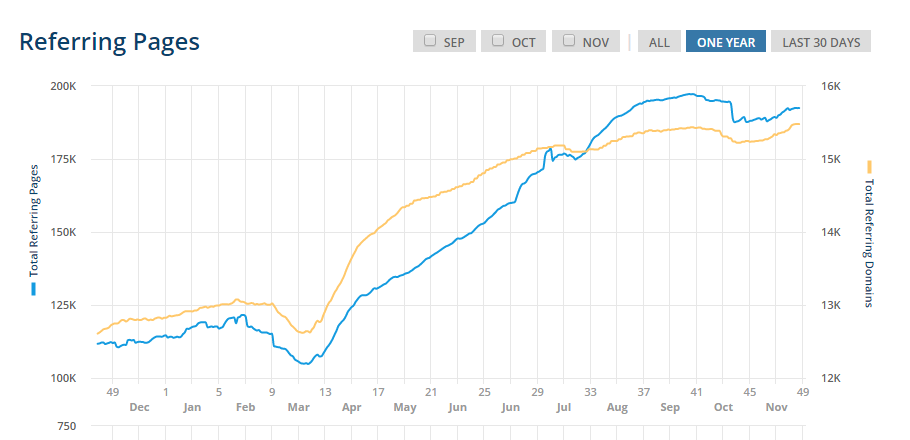
As long as your backlink count (and total referring domains) are both steadily increasing, you’re doing something right, and search traffic will almost always go up.
But what if you see a downward trend or a plateau?

That tells you that your site as a whole isn’t attracting any new backlinks.
Uh oh.
That needs fixing.
It’s a clear sign that your content promotion isn’t up to par.
You should be spending at least as much time promoting your content as you do creating it. If your blog is relatively new, you should spend even more time.
Aim to get at least 20 high quality links from your promotion efforts. This takes a lot of time and persistence. You might have to send out 500+ emails per article. Do it.
You won’t see the results immediately, but after a few months, your search traffic will increase and keep rising if you keep up the work.
27. Email the sources you quote in your articles
If you are writing articles that require you to cite lots of sources, you have yet another great way to improve your content marketing and links!
Contact the most cited sources with the article, letting them know how important their work was to you, and ask if they would be willing to share it along their various channels of influence.
Say please, ask nicely, and you’re likely to get a positive response.
Again, this can be a great way to boost your credibility and get your content out there!
28. Reach out to people you see sharing similar content
If you ever see people who are constantly sharing content related to your niche and who are your Facebook friends, reach out to them and ask for a friendly share.
More often than not, if your content is good, people will be more than happy to do this, and it will likely win you a regular “share buddy” you can go to whenever you create some pretty exceptional content (which, if you remember points 3-5, should be pretty much always).
Besides, a lot of social media people and content creators are always looking for high-value stuff to share. You’re doing them a favor by letting them know about your content!
29. Make your content useful
Think about the basic principles of content marketing.
Your content needs to have value in order to accomplish anything. If your audience isn’t finding your content useful, they’re not going to continue to read it.
This is something you want to catch as quickly as possible, or it can become tremendously hard to reverse.
Here’s what happens with most somewhat loyal readers:
- they generally like your content, maybe even love it
- but then they read a post that isn’t very useful. That post alone won’t deter them from coming back.
- if they come across more posts that aren’t useful within a short time period, they will not come back.
Take a second to understand that sequence.
It’s easy to produce a less than stellar post and let it slip by because your numbers won’t take a hit. In the short term, most of your readers will still be loyal to you.
But if you let 2, 3, or 4 posts that aren’t very valuable slip by, you’ll start seeing your readership decline exponentially.
It happens all the time to even popular sites. They lose a large percentage of longtime loyal readers in just a few months because they start to cut corners.
You can’t afford to do this…ever.
Diagnosing ‘weak’ content: In order to evaluate how your audience perceives your content, you need a few different metrics to get a full picture.
There are a few different symptoms that you’ll need to keep an eye out for.
Symptom #1: Your email open rate goes down…down…and down
I suggest keeping a close eye on your email subscribers at all times. These are typically your most loyal readers, which means they provide reliable, accurate information.
Here, you need to examine your email open rate. All major email marketing service providers offer some sort of report in your account that should show you your overall email open rates over time.
Something like this:

If it’s staying steady or even going up, great. You’re doing something right.
But if it’s steadily going down, that’s a sign that people are losing interest in your content. If it’s only a slight downward trend, you may be doing okay, but you’ll want to keep an eye on it.
The reason why this is a good metric to look at is because these loyal readers will open most of your emails if they expect there is valuable content in them (why wouldn’t they if your content will improve their lives?)
If your numbers are dropping, it means that more and more of your readers aren’t expecting to find useful content in your emails.
Symptom #2: The number of “actionable comments” goes down dramatically
Truth be told, I don’t really worry about the sheer number of comments I get on posts.
Sometimes I get 20 comments; other times I get 300. A lot of that depends on whether what I am writing about is interesting to all or only certain parts of my audience.
What I do care about is how many actionable comments I get.
For me, an “actionable comment” is a comment that demonstrates that the reader not only liked the content but actually took action to apply it.
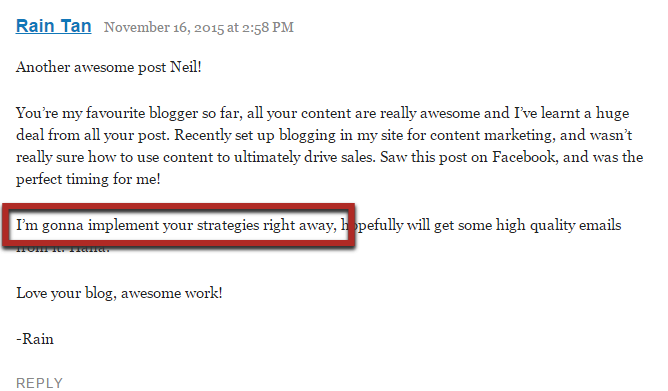
Makes sense, doesn’t it? If you want to see whether your readers find your content useful, see if they actually use it.
Cranking up the value and winning back your readers: The reason behind either (or both) of these symptoms is usually the same.
Some time in the recent past you started publishing content that wasn’t up to the standard you set before.
It’s really easy to do, and there are many things that can cause it:
- distractions in your personal life
- falling into a content creation “grind”—feeling burnt out
- getting overwhelmed by other parts of your work or business
First of all, know that it’s okay. Everyone (including myself) has dips in the quality of their content once in awhile.
But the best marketers spot it really quickly and fix it.
The solution is actually quite simple: start putting more effort into creating more valuable content.
If you can’t do that for some reason, it might be time to at least temporarily hire a writer or editor to help you.
If you’re just feeling a bit lost with your content creation, it may be time to learn some new ways to add value to your content. Here are a few posts I’ve written that will help you inject some new life into your work:
30. Don’t do everything on your own
There is no sustainable way to do everything by yourself once your business reaches a certain size.
If you do try to, three things can happen:
- you get burnt out
- you can’t keep up, and your business suffers large setbacks
- you have to limit your growth
All these cases are obviously bad. And if your current content marketing system relies on you doing everything, it’s broken.
It is not set up for long term success, no matter how passionate, persistent, and intelligent you are.
If this sounds like you, and you feel that one of those three scenarios is happening (or has already happened), you need to take a step back.
Know when it’s better to get help: You wear a lot of different hats as a content marketer.
Content marketing requires a lot of different skills:
- research
- design
- copywriting
- editing
- promotion
- PR
- link building
And more…
Unless you’re an extremely rare exception, you’re not amazing at all those things.
Like most marketers, you’re probably good to great at a few of them and mediocre at the rest.
By all means, you can improve those weaknesses, or you can get help.
When I tell business owners and marketers to spend more on freelancers (or additional employees), they always resist, saying something along the lines of:
I can’t afford to do that.
They’re right and wrong at the same time.
With their current content marketing system, they can’t afford it. Their growth and results can’t justify increased spending.
But what they don’t realize is that by doing everything themselves, they are costing themselves a huge amount of money.
Hiring good freelancers almost always makes you more money than it costs for a few main reasons:
- they’re better than you – instead of struggling with one of your weak skills, like design, you can hire a professional graphic designer who spends all their time improving that one skill.
- it frees up your time – with help, you have more time to spend on the parts of content marketing you excel at. For example, I love creating content, so I do that. Getting help with other things allows me to write several posts a week, and you can’t do that if you’re doing everything else too.
- it minimizes catastrophes – if you get sick and you’re doing everything on your own, everything shuts down, which is extremely costly. When you have help, others can fill in to keep everything running smoothly.
I really hope that makes sense.
When you hire intelligently, you make even more money, AND you’ll get to do the work you enjoy the most.
How do you hire intelligently? I’ll be honest, hiring the right people isn’t easy. If you hire people who aren’t professional, they might leave you hanging unexpectedly, which can mess up your content strategy.
My first big advice is to know exactly what you want.
Hire for a very specific position (e.g., copywriter, funnel expert, designer, etc.), and make your requirements very clear.
As an example, take a look at 3 job postings I posted on Quick Sprout in 2015:
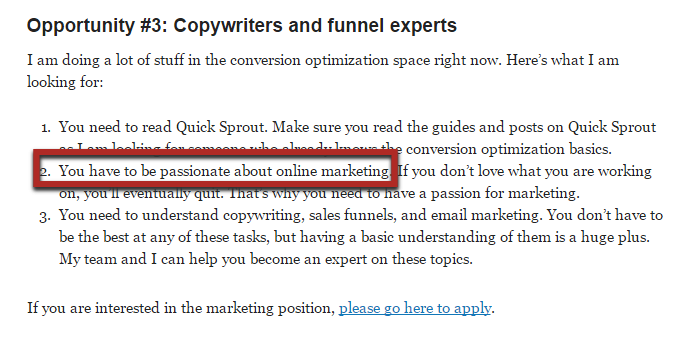
You’ll notice that the main thing I look for, besides knowledge, is passion.
I like working with people who love their work and spend a large part of their lives doing it. These are the most likely people to act like professionals and always deliver on their promises.
As long as you return the favor by paying promptly and treating them like professionals, they will make your life a lot easier.
One more thing that you absolutely must do when making hiring decisions is to talk to the person you are considering to hire (phone, Skype, or whatever you prefer).
Get a sense of their expectations so you can determine if they’re a good fit for what you can offer.
Sometimes, you’ll get a gut feeling telling you that you should hire a particular person; other times your gut will tell you to pass. More often than not, that gut feeling is right, so trust your instincts.
Finally, don’t hire all at once.
Once those marketers and business owners see how hiring could actually help them, they often hire too many people too fast.
When you’re planning on working with someone long-term, rushing is the biggest mistake you can make.
Start with one position.
Even if you find a great person to hire, chances are you’ll still do a few things wrong. When you start with just one position, it gives you a chance to learn from your mistakes and then apply those lessons to the next person.
Slowly transition to the business structure you want instead of trying to make it happen overnight.
31. Improve your conversion funnel
One of the biggest reasons why business owners think that content marketing isn’t very effective is that they don’t know how to turn it into sales.
They do a good job when it comes to creating high quality content, but then they expect that their readers would spontaneously start buying their products.
Or they don’t want to upset their audience by selling something to them.
If you relate to either of these types of people, you need to understand that the whole point of content marketing, like most other types of marketing, is to increase profits (sales).
Without any return from content marketing, how are you supposed to justify the investment in more content? You can’t.
Additionally, why would you feel bad about selling a product that will genuinely help your customers?
If you’ve been having success with your content, you understand your reader very well. No one else is in as good a position to create a useful product for them as you are.
So if you don’t have a product to sell, get one.
The more interesting problem to diagnose is when you have poor sales of an actual product despite getting a good amount of traffic.
Possible diagnosis #1 – Your conversion funnel needs work: All products have conversion funnels; some just aren’t very well defined.
A conversion funnel simply describes the path that a customer takes to become an actual customer from being a first time visitor:

Yes, there are many different paths in each step, but you should be able to define the main channels they pass through.
For example, “visitor > email subscriber > sales pages > customer.”
Once you have your funnel defined, you can use analytics to see where they are dropping off in this funnel.
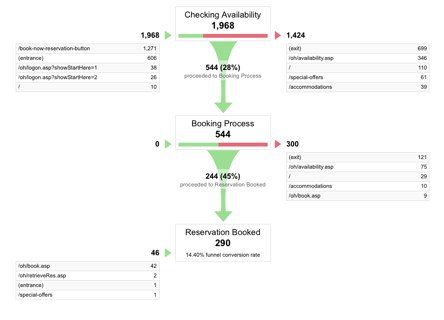
You can create a sales funnel in Google Analytics or use some more advanced sales analytics software like Kissmetrics.
If you’re not sure how to build an effective conversion funnel, I have an in-depth guide that will show you how to.
Possible diagnosis #2 – You don’t have product-market fit: Now, if you actually have a good funnel but you can’t figure out why barely anyone is buying your products, you likely have a poor product-market fit.

Your product-market fit is basically a measure of how well your product meets the needs of your audience.
If no one is buying, it means one of two things:
- your product sucks
- you’re targeting it to the wrong audience
Be honest with yourself about your product: is it really good enough to sell? I rarely see this problem with content marketers, however, since they tend to give as much value as possible.
The more common problem is creating the wrong product for your audience.
For example, if you had a blog catered to SEO beginners, would it make sense to try to sell an advanced technical SEO crawler to them?
No, it wouldn’t. Instead, a basic rank tracking tool or email outreach tool would be much more useful for them at the moment.
It’s not that your product isn’t good—it’s that your audience doesn’t have a need for it.
Instead, you should have been writing content that attracts experienced SEOs rather than beginners. Then, you’d be selling the right product to the right audience.
To fix this problem, you either need to create a different product or pivot your content marketing strategy to target the right audience for your product.
32. Collect emails
Do you know what the most engaging traffic source is for Quick Sprout? It’s not search or even social media it is actually email traffic. Over the years, I’ve been collecting email addresses through pop-ups and sidebar opt-in boxes.
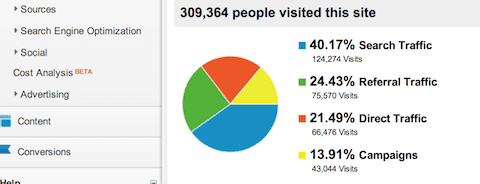
As you can see, emails account for 13.91% of my overall traffic (it’s listed under campaigns). But what’s really interesting is that those people account for 41% of the overall blog comments. Also, they are 3.9 times more likely to share the content via the social web versus people who came to the site from another traffic source.
The beautiful thing is that it’s not just Quick Sprout who is experiencing this. We are also seeing similar numbers with my other two blogs: KISSmetrics and Crazy Egg.
So, how do you go about collecting more email addresses?
Through WordPress plugins like Popup Domination and Modal Dialog, you can create a pop-up that plugs into your current email solution provider. In addition to that, you can also collect emails by placing offers within your sidebar and below your blog posts, similarly to how I do it on Quick Sprout.
If you don’t have much time, focus your energy on the pop-up as it tends to drive three times the opt-ins compared to a sidebar or below-the-post offer.
If you aren’t sure how to set up a pop-up, read this article.
Here’s some interesting data that might help you create an effective pop-up:
- Courses convert better than ebooks – most bloggers typically give away ebooks, but from extensive A/B testing we’ve found that 7-day courses or 30-day courses convert 6% better than ebooks. The main difference between a course and an ebook is that a course is structured more like classroom learning. In a course, you give people bit-sized information that they can easily understand over a period of time.
- Don’t forget to add a dollar value – although the information you are giving away is free, it doesn’t mean that it isn’t worth anything. When I added the text “$300 value” to my sidebar opt-in, my opt-in rate increased by 22%.
- Be aggressive – there are different settings with your pop-up. From delaying when it shows up to only showing it to people who’ve viewed multiple pages to not showing it on mobile devices, you can get very specific on who sees it and who doesn’t. I’ve found that showing the pop-up to everyone upon their first visit generates 23.5% more opt-ins versus delaying the pop-up by ten seconds.
- Color matters – my developer tested out 33 colors (blue, green, red, black, white, pink, grey, purple, yellow, orange, brown, as well as two shades of each color) for the call-to-action button on my pop-up as well as the pop-up on three other blogs. We found that red, green, orange and yellow tend to be the highest converting cal- to-action colors. The colors black, brown and purple where the lowest converting call-to-action colors. Make sure you test these colors on your blog to see which ones work for you.
- Don’t ask for too much information – on web-based pop-ups. I typically ask people to enter their name and email. When I performed an A/B test, in which the B test only asked for email only, my conversion rate increased by 17%. What was interesting is that when I did the same A/B test just for mobile traffic, my mobile opt-in rate increased by 39.3%.
- Placement is everything – plugins like Popup Domination have multiple design options. Sometimes the email opt-in forms are on the right side of the message, while other times they may be right underneath the offer message. When I tested this on Quick Sprout, I found that having the opt-in below the offer message resulted in an 11% increase in conversion.
Once you have the emails, make sure you notify your readers every time you publish a blog post. This is how I drive 13.91% of my traffic to Quick Sprout each month.
33. Convert readers into fans
Do you know who does a great job of converting readers into fans? WetPaint. Based on an algorithm they created, if they feel that you are an engaged reader, the will display a small box over the content, asking you to like them on Facebook or Twitter to read the rest of the content.
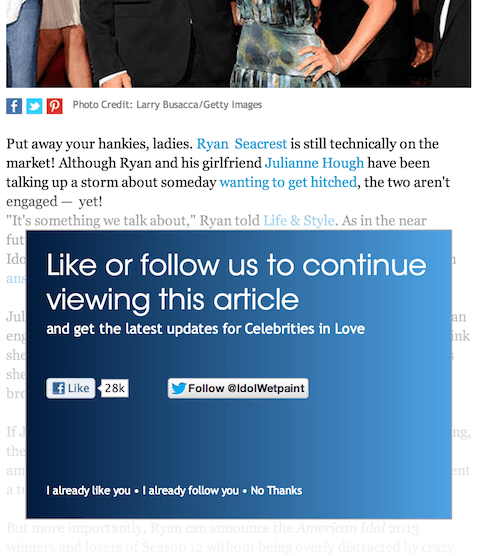
If you don’t want to, you can just click “no thanks” and continue reading their blog. But that one approach has enabled them to get thousands of Facebook fans. Just look at their WetPaint Facebook channel: they have over 380,000 fans.
Can you guess what kind of results this is producing for bloggers? I did a quick test on Quick Sprout over the weekend, and I was able to convert 2.9% of my visitors into fans. That percentage may go down over time because I have a good amount of repeat visitors, but I could counteract the decrease of that percentage by A/B testing the copy. Plus, my version wasn’t as good as WetPaint’s, and I had a few bugs on Internet Explorer and Firefox, so I had to remove it. 
I know those numbers don’t seem huge, but if you are getting 100,000 unique visitors a month, you will be growing your fan page at a pace of 2,900 fans a month. After 12 months, you should have roughly 34,800 fans to direct to your blog or any other website whenever you want.
My test run was so successful that I will be rolling out a bug free version of that on Quick Sprout over the next month or so.
Encourage your readers to not only share your content across the social web, but also to follow you. Whether you do what WetPaint does or ask your readers directly to follow you on Facebook within your blog sidebar, there are many ways you can grow your social channel. Just pick one or two social channels and encourage your readers to engage with you on it.
In the long run, this will help your content spread more through the social web, which not only will increase your traffic, but search engine rankings as well.
34. Create content worth marketing
Sure, this point may seem redundant, but it is worth repeating.
If your content sucks, why are you even trying to market it? What you are creating needs to offer value to the world, and even if it isn’t 100% original, it should offer insights and present the information in a way that the audience isn’t used to seeing.
You need to create great content before you can be great at marketing it.
Conclusion
Content marketing can be overwhelming.
There are so many different channels to market your content on that you may feel you can’t even choose which one(s) to pursue.
But relax, content marketing shouldn’t be this scary.
What’s most important is to create good content and do what you can to share it. Once you have mastered the basics, you can worry about the hard stuff.
By putting these tips to practice, you can make your content marketing more potent and get more bang for your buck.
Want more ways to improve your content marketing and get more traffic?
I’ve compiled a list of 10 more articles you should read that will not only teach you how to improve your content marketing but will also show you how to generate more traffic and sales.
Here it is:
#1: How to double your traffic through infographics
Although everyone is using infographics these days, they are still powerful at producing results.
At KISSmetrics, we were able to drive over 2 million visitors to our site and generate 41,000 backlinks by creating 47 infographics. That’s not bad, considering we spent $28,200 to produce the graphics.
If you want to learn the exact strategy we used to create these infographics, all you have to do is follow the steps in this article. It will teach you what you need to do to generate 60,000 visitors a year from an infographic:
- How to Determine the Elements of a Good Infographic
- How to Come up with Infographic Topics that Actually Work
- How to Create a Useful and Shareable Infographic
- How to Get the Infographic Designed
- How to Distribute Your Infographic
- How to Test Different Types of Infographics
#2: The advanced guide to content marketing
Content marketing is more than just writing and promoting content. There is a whole process you need to follow if you want to be successful at it.
I’ve created a 30,000-word guide that covers the A to Z of content marketing. It will teach you the following elements of the content marketing process:
- How to build a strong foundation
- How to generate content ideas
- How to plan your content creation strategy
- How to write content like a pro
- 12 content writing secrets that you ought to be using
- Content creation templates
- How to overcome content roadblocks
- How to optimize your content for search
- How to promote your content for traffic and sales
- How to monetize your content
#3: The complete guide to consumer psychology
Not knowing how your consumers think is a major obstacle to your success in content marketing. If you don’t know what makes your readers tick, you won’t be able to cater to them with your content creation and promotion efforts.
To help you understand how your customers think, I’ve created a 25,000-word guide on consumer psychology.
Here’s what you’ll learn by reading it:
- The mind of today’s customers
- The power of emotions
- The psychology of online consumption
- How colors affect decisions
- Small psychological tactics that deliver big results
- The psychology of pricing
- How to avoid friction
#4: How to create viral content
I wrote a blog post a few weeks ago that broke down the steps I took to increase my blog traffic by 206%.
Through data and examples, I showed you the process I use to find and create content that will get shared.
So, if you want to grow your blog traffic, read the second section within that article. It discusses data points such as:
- Social shares versus content length
- How to generate ideas that will get shared
- Quick tools you can use to help you generate ideas
- How Upworthy exploded in its growth
- Headline templates you can use
- The number of social buttons you should place on your blog
#5: Skyscraper technique
Brian Dean wrote a great article on how he increased his search traffic by 110% in 14 days by using one simple technique… the skyscraper strategy.
In essence, it teaches you:
- How to find link-worthy content
- How to make it even better
- How to find people to link to it
A good example of this is his article on Google’s 200 ranking factors. In the article, Brian describes in depth each element Google looks at when determining how to rank a website.
Because Brian was able to create the most extensive list, when he did his outreach to build links, it was a slam-dunk. Bloggers were more than happy to link to him because the content was that good.
#6: What analyzing 100 million articles taught us
The beautiful part about online marketing is it gives you access to a ton of data. With the data, you can quickly figure out what works for others and how to replicate it for your own business.
Buzzsumo’s team published an article detailing the findings from their analysis of 100 million articles.
For example, they learned that:
- Having at least one image per post doubles the number of social shares a post gets.
- Having Facebook thumbnails for articles increases Facebook shares by roughly 3x.
- Having a Twitter thumbnail doubles Twitter shares.
- The emotion to appeal to is “awe.”
- Infographics and list posts are the two most commonly shared types of articles.
And it doesn’t stop there… Read the article to learn all of their findings.
#7: The differences between B2B and B2C content marketing
Writing content for businesses is different from writing content for consumers. I’ve created a 37-point checklist that breaks down the differences. It also teaches what you need to do in order to appeal to both audiences.
Some of the key points to keep in mind when writing for consumers are:
- Don’t forget the emotional crack – consumers have a shorter attention span than business readers do. That’s why you need consumer content to be edgier and shorter.
- Be trendy – if you want your content to gain a lot of traffic, look at trends. Trendier content does better than evergreen content in the consumer world.
- Timing is everything – you should try to break stories. Use Google Trends and Twitter to stay on top of the latest conversations.
On the flip side, when writing for businesses:
- Always use data – stats and accuracy are important in the business world. Use data to back everything up.
- Give them more – offering ebooks and PDFs at the end of each post is a great way to build a loyal audience and collect emails.
- Use stats within your headlines – headlines that contain data usually get shared more often.
To get a complete list of differences between B2B and B2C content marketing, read the full article.
#8: Emotions that make marketing campaigns go viral
The Harvard Business Review wrote a great article on how emotions can make campaigns go viral. Marketing is expensive. If you can make your content go viral, you’ll get more ROI from it.
Here’s what you’ll learn in this article:
- How to create a viral coefficient greater than 1.
- How to tie your brand to an emotional message.
- How to tie your content to the public good.
If you take one thing away from the article, let it be how to create a viral coefficient greater than 1. Without that, your content won’t be going viral.
#9: How to measure your content’s performance
Everything in marketing needs to be profitable. If it isn’t, you can only do it for so long. You don’t have to have a direct profit, but as long as you know there is indirect ROI, you’re fine.
The Content Marketing Institute broke down 6 ways you can measure the performance of your content marketing. They aren’t just looking at direct ROI. They also show you how to measure indirect ROI.
These measurement techniques will teach you how to:
- Track brand awareness
- Find out what content pieces are driving the most referral traffic
- Use social shares to gauge how much people like your content
- Assess post performance on LinkedIn
- Assess post performance on Twitter
By using analytics and data, you’ll be able to create content that people want to read and share versus content that doesn’t drive sales.
#10: How to get your fans to create and share content
Creating content is time-consuming and expensive. But what if I told you that you can get your fans to not only create content for you but also to promote it.
I’ve created an infographic that breaks down how to do that. Here are the four techniques I go over:
- Trust – without your fans’ trust, you won’t get user-generated content.
- Reach – how user-generated content can help you get more reach.
- SEO – the more content you have, the more search traffic you’ll receive.
- Labor savings – how getting fans to create content will save you money.









